|
Symposium site/Hotel information
Hotel auf der Wartburg
Wartburg, 99817 Eisenach
Germany
Phone: +49-3691-7970 Fax: +49-3691-797100
Homepage: http://www.wartburghotel.de
Steigenberger Hotel Thüringer Hof
Karlsplatz 11
99817 Eisenach, Germany
Phone +49 3691 28-0
Fax +49 3691 28-190
Homepage: http://www.steigenberger.com/en/Eisenach
Eisenach and Wartburg Castle
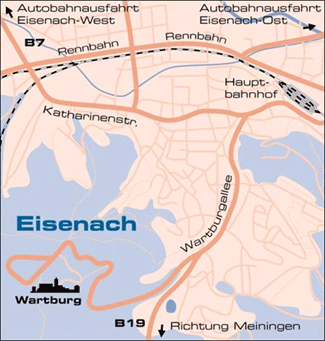
- Location and Directions
- Hotel auf der Wartburg is located in a central German city of Eisenach, at the very foot of the UNESCO World Heritage Wartburg Castle, with views over the city and the Thuringian forest.
Wartburg Castle and hotel is about 10 minutes by car; around 40 minutes on foot to the top of the hill where the castle is located.
Steigenberger Hotel is located directly in the city centre opposite the middle-aged Stadttor (city gate) and is one of the most traditional houses in the Luther-City Eisenach. It is only 300m away from Eisenach station.
- From Frankfurt:
Eisenach is accessible by train or car. You can take the Intercity express train from Frankfurt International Airport or Frankfurt am Main (direction of Dresden) and get off at the ICE station of Eisenach. From the station, take a taxi to the hotel which is directly at the foot of the Wartburg Castle. It takes about ten minutes.
- From Frankfurt by car:
Highway N° 7 (direction: Dresden) → "Kirchheimer Dreieck" → Highway N° 4 (direction Dresden) → leave "Eisenach-Ost" → in town Eisenach: follow the with signs to "Wartburg"
- Location
- Eisenach is about 60 km (37.29 miles) from Erfurt airport. Distance and time taken to reach Eisenach from relative cities in Germany are shown below:
- Frankfurt am Main 230 km (southwest)
-- 2 hours by car / 1,5 hours by train
- Hamburg 360 km (north)
-- 3,5 hours by car / 4 hours by train
- Munich 490 km (south)
-- 4,5 hours by car / 4 hours by train
- Leipzig 200 km (East)
-- 1,5 hours by car / 1 hour by train
- Stuttgart 370 km (Southwest)
-- 3 hours by car / 3,5 hours by train
Routes to Eisenach by car
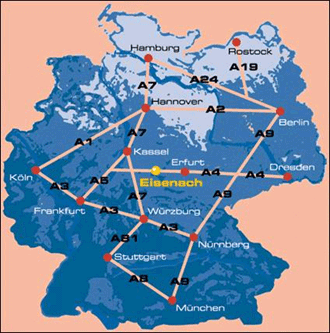
About Wartburg
The conference venue, the Wartburg, is arguably the historically most significant castle in Germany. The castle was the site of a number of important events in German history and became the epitome of what a "Burg" is and means: the fortified residence of a nobleman and final refuge of his subjects, typically located on top of a hill. The significance of the Wartburg has been acknowledged by UNESCO in 1999 when the castle was added to the World Heritage List as an "outstanding monument of the Feudal Period in Central Europe".
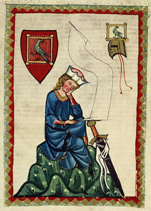 In the Middle Ages, around 1207, the Wartburg was the scene of the Minstrels' Contest, also known as "Sängerkrieg", the singer's war. While accounts of historic facts are not confirmed, the poems of the Sängerkrieg form an important collection of Middle High German literature. Some of them were written by Wolfram von Eschenbach and Walther von der Wogelweide, the most celebrated German lyric poets of their time. In the 19th century, the Sängerkrieg became popular again and inspired authors and composers alike, the most famous example being Richard Wagners "Tannhäuser". In the Middle Ages, around 1207, the Wartburg was the scene of the Minstrels' Contest, also known as "Sängerkrieg", the singer's war. While accounts of historic facts are not confirmed, the poems of the Sängerkrieg form an important collection of Middle High German literature. Some of them were written by Wolfram von Eschenbach and Walther von der Wogelweide, the most celebrated German lyric poets of their time. In the 19th century, the Sängerkrieg became popular again and inspired authors and composers alike, the most famous example being Richard Wagners "Tannhäuser".
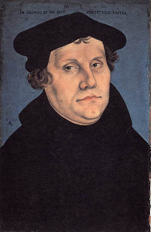 Some 300 years after the minstrels, Martin Luther stayed at the castle for more than a year. Following a staged kidnapping ordered by Elector Frederick the Wise, Luther had been taken there for his safety after being excommunicated by Pope Leo X for his refusal to recant. When the kidnappers and Luther approached the castle and he realized his real situation of being safe, he was inspired to one of his famous church songs "Ein feste Burg ist unser Gott" ("A sturdy castle is our Lord"). While living in the castle disguised as a knight, Luther translated the New Testament into German. This was the first translation of a major part of the bible into a modern language in over a millennium. The translation together with Luther's masterful use of German was decisive for establishing German as a literary language. Besides being an outstanding religious and political figure, Luther thus has a similar significance for German literature as, e.g., Dante Alighieri for Italian. Some 300 years after the minstrels, Martin Luther stayed at the castle for more than a year. Following a staged kidnapping ordered by Elector Frederick the Wise, Luther had been taken there for his safety after being excommunicated by Pope Leo X for his refusal to recant. When the kidnappers and Luther approached the castle and he realized his real situation of being safe, he was inspired to one of his famous church songs "Ein feste Burg ist unser Gott" ("A sturdy castle is our Lord"). While living in the castle disguised as a knight, Luther translated the New Testament into German. This was the first translation of a major part of the bible into a modern language in over a millennium. The translation together with Luther's masterful use of German was decisive for establishing German as a literary language. Besides being an outstanding religious and political figure, Luther thus has a similar significance for German literature as, e.g., Dante Alighieri for Italian.
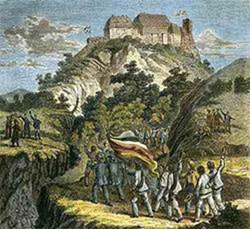 Another 300 years later, in the wake of Napoleon's victory over Prussia in the battles of Jena and Auerstädt 1806 and his defeat in the battle of Waterloo 1815, student groups from Jena and other places organized a festival at the Wartburg. They demonstrated for a liberal constitution and a national state. The colors black-red-gold were used as a symbol for a liberal revolution and unified nation for the first time. Another 300 years later, in the wake of Napoleon's victory over Prussia in the battles of Jena and Auerstädt 1806 and his defeat in the battle of Waterloo 1815, student groups from Jena and other places organized a festival at the Wartburg. They demonstrated for a liberal constitution and a national state. The colors black-red-gold were used as a symbol for a liberal revolution and unified nation for the first time.
******
The Wartburg isn't the only significant landmark of the region. The entire region is imbued with German history and culture. The chain of cities Jena, Weimar, Erfurt, Gotha and Eisenach stretching across the state of Thuringia have been the scene of many influential developments in science, literature, music, and architecture. The city of Eisenach at the foot of the Wartburg for example is the birthplace of Johann Sebastian Bach. A beautiful museum houses an impressive exhibition about his life, time, and music.
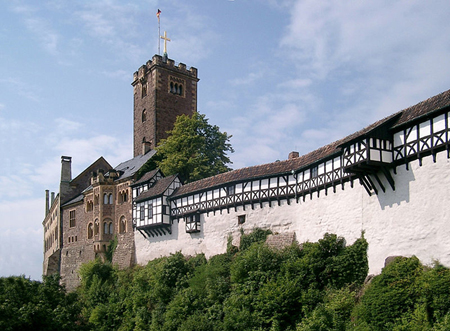
|

